Melvyn Peters and Thandi Klaasens at the famed Rainbow Restaurant and Jazz Club in Pinetown. (All images by Rafs Mayet)
There’s a definite dearth of documentation (the alliteration is mine and it’s deliberate) of South African jazz, evinced by the lack of photography books on the subject. Visually and verbally there aren’t too many options to turn to, although the written word fares much better than the images.
The book Beyond the Blues: Township Jazz in the ’60s and ’70s by Basil Breakey set the standard. It was edited by Stephen Gordon, himself a music photographer. Although several photographic elders — like Alf Kumalo, Peter Magubane, Ranjith Kally, Chris Harris, Wilfred Paulse and George Hallett did include some music pics in their publications — they weren’t always jazz-specific shots. Rather, they were lumped among other cultural images.
Most jazz photography books are real labours of love, like the series published by the Dane, Lars Rasmussen, which includes Cape Town Jazz, 1959-1963: the Photographs of Hardy Stockmann; Jazz people of Cape Town; Mbizo: A Book on Johnny Dyani, and Sathima Bea Benjamin ― Embracing Jazz, as well as a discography of Abdullah Ibrahim.
Then there’s a book on female vocalists by Mike Mzileni and ZB Molefe, A Common Hunger to Sing: A Tribute to South Africa’s Black Women of Song, 1950-1990. Later on, Bra Mike also published a book called All that Jazz: A Pictorial Tribute, through ESP Afrika (the folks who run the Cape Town International Jazz Festival), together with Safika Publishers.
Safika and ESP also published a few more jazz photo books: Jazz Rocks by Rashid Lombard, A Female Perspective which included the work of photographers Tina Smith, Neo Ntsoma, Shelly Christians, Nolusindisile “Cindy” Waxa, Thania Petersen and Ingrid Masondo, among others. They also produced a book celebrating the 10 anniversary of the festival, which consisted of performance images taken on the different stages by several photographers who covered the festival during that period. This was edited by videographer and photographer Shadley Lombard.
Jürgen Schadeberg also chips in with some music and cultural photos in The finest photos from the old Drum and The Fifties people of South Africa, later on releasing Sof’town Blues: Images from the Black ’50s and Jazz, Blues and Swing: Six Decades of Music in South Africa
And then there’s the more recent seminal Keeping Time: 1964-1974, The Photographs and Cape Town Jazz Recordings of Ian Bruce Huntley, which is a very important visual and audio record of the jazz music scene in both Cape Town and Johannesburg. Painstakingly restoring Huntley’s scans over a two-month period, Cedric Nunn helps to do justice to the work of this important historical book.
Huntley, who lives in Pietermaritzburg, also contributed financially to the publication of Breakey’s book. He bought a saxophone for Kippie Moeketsi when he brought him down to Cape Town for some gigs, and often had musicians sleeping on the floor of his flat when they couldn’t get home after a gig. He’d go into townships and community halls, set up two microphones on the stage, hook them up to a reel-to-reel tape recorder and proceed to photograph the gig. This important body of work is now available through the Electric Jive website, which is also a treasure trove of rare old recordings.
My generation of photographers like Peter McKenzie, Cedric Nunn, Rashid Lombard and others active in the ’80s and ’90s, often sought refuge in music after witnessing and documenting the traumas of those times. I’d find a few frames at the end of a roll of film featuring images of musicians, after covering a meeting or rally or funeral or some struggle event.
 Zim Ngqawana
Zim Ngqawana  Steve & Bokani Dyer
Steve & Bokani Dyer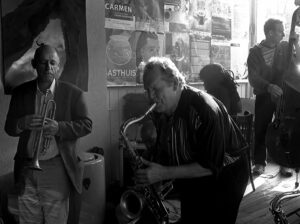 Sean Bergin
Sean Bergin Robbie Jansen
Robbie Jansen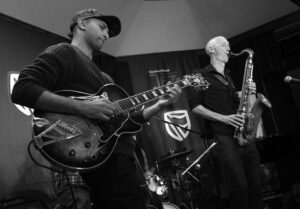 Reza Khota & Buddy Wells
Reza Khota & Buddy Wells Nduduzo Makhathini
Nduduzo Makhathini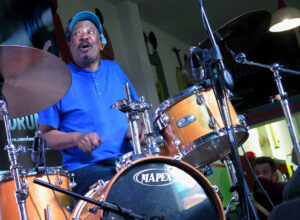 Louis Moholo Moholo
Louis Moholo Moholo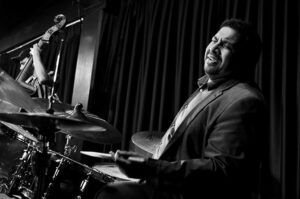 Kesivan Naidoo
Kesivan Naidoo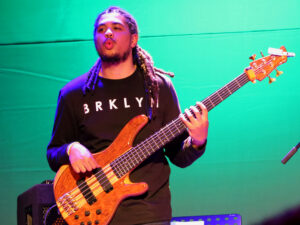 Benjamin Jephta
Benjamin Jephta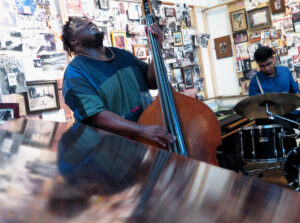 Dalisu Ndlazi & Riley Giandhari
Dalisu Ndlazi & Riley Giandhari
Jazz through the years, as captured through Ras Mayet’s lens
Culture and music were important components on such occasions and someone like Stephen Gordon had an insider’s view. Often co-ordinating and organising the musical side of such events, Gordon photographed and compiled a huge body of work that goes beyond just performances and has several important images that should be published and archived somewhere.
More recently, there’s a current crop of lensmen, like Siphiwe Mhlambi, Lindo Mbhele, Muntu Vilakazi, Tseliso Monaheng, Gregory Franz and Oscar Gutierrez, who contributed photos to David Coplan’s book Last Night at the Bassline: A Tribute.
Why don’t we have more books about these historic venues like the Zambezi Room, the Ambassador and the Naaz, the Beverley Lounge and the Yellow Door in Cape Town. There’s the Goodwill Lounge, Starpoint 5, the Executive Hotel in Umlazi and the Blue Note in Cuckoo Lane in Durban and, of course, the Rainbow Restaurant and Jazz Club in Pinetown (to give it its full and grand title). Jozi also had the Pelican (Lucky’s), Kippies, the Quirinale Hotel and other joints in Hillbrow. All, at some stage in their existence, hosted jazz gigs and were important in sustaining the music, yet so little has been researched and is known about these venues that allowed musicians to do what they love.
In terms of the written word, there’s: In Township Tonight!, also by David Coplan; Soweto Blues: Jazz, Popular Music and Politics in South Africa by the doyenne of jazz journalists, Sis’ Gwen Ansell; Marabi Nights: Jazz, ‘Race’ and Society in Early Apartheid South Africa by Chris Ballantine; Unsung: South African Jazz Musicians under Apartheid by Chats Devroop; Yakhal’Inkomo: Portrait of a Jazz Zlassic by Percy Mabandu; Chris McGregor and the Brotherhood of Breath: My Life with a South African Jazz Pioneer by Maxine McGregor; The Story of South African Jazz:Volume One by Struan Douglas; A Silent Way: Routes of South African Jazz 1946 to 1978 by Julian Jonker; South African Music by Carol A Muller, who also wrote Musical Echoes: South African Women Thinking in Jazz with Sathima Bea Benjamin, and Still Grazing by Hugh Masekela and Dr Michael Cheers.
There are also the booklets by Chimurenga Press; Aryan Kaganof’s: The Forest and the Zoo, which is about bassist Johnny Dyani; and The Making of Mannenberg by John Edward Mason, which tells us about that song of Abdullah Ibrahim that was regarded as the unofficial anthem during the dark days of the struggle and was played at rallies and other events. It was popularised by the likes of Basil Coetzee and Robbie Jansen who played on the original recording.
There are several publications and articles out there, but it’s all a little disparate. Nothing is consolidated and co-ordinated into a single, accessible repository or archive that can be preserved and be a resource for students, scholars and academics of the music that we love so much. There’s still much more to be discovered and documented.
In other parts of the world, if you want to find out about, say Charlie Parker or John Coltrane, Stephane Grapelli or Dave Brubeck, you’re spoilt for choice because there has been lots of research and publications on these icons and others of similar ilk.
Why isn’t there more research, information and publications about our own people? Kippie Moeketsi, Timothy Ndaba, Ntemi Piliso, Winston Mankunku Ngozi, Lionel Pillay, Agrippa and Nelson Magwaza, Johnny Fourie, Bheki Mseleku, Thandi Klaasen, Dolly Rathebe, Dorothy Masuka, Janet Tsakane, Thandeka Ngono, Pinise Saul, Theo Bophela, “Cups and Saucers” Nkanuka, Basil Metaxis, the Kerdachi brothers, Milt Johnson, Kenny and Harold Jephta, Gerald Sloan, Lulu Gontsana, Bobby Mofokeng, Bobby Timol, Basil and Cliffie Moses, Zim Ngqawana, Themba Mehlomakulu, Duku Makasi, Gilbert Matthews, Tete Mbambisa, Ronnie Madonsela, Louis Moholo Moholo, Sean Bergin, Dalton Khanyile, Dugmore Silinga, Willie Neti, Rogers Mthimkulu, Roger Khoza, Sandile Shange, Ezra and Duke Ngcukana and their father Mra “Christopher Columbus” Ngcukana, the Schilders — that musical dynasty from the Cape, and so many others.
They and many more jazz musicians contributed lots to this “river of culture that we’ve been bequeathed” to quote Bra Ndikho Xaba. We need more of the visual and verbal in our vast musical history that’s under-documented, under-recorded and, too often, under-appreciated. There’s that alliteration again.